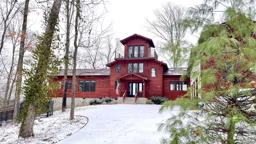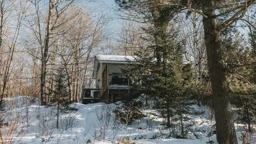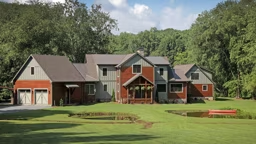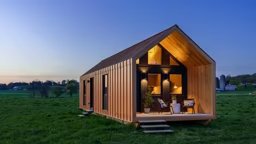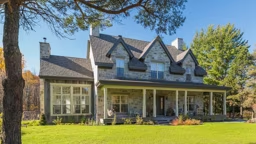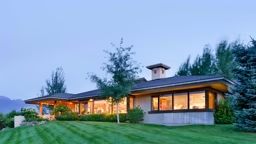A maverick redo reveals endless vistas
Story by Fran Sigurdsson Photos by Heidi A. LongWhen the view from a cabin is BIG – we’re talking 7,000-foot-high Big Mountain in Whitefish, Mont. – you don’t want something big in the way. But what’s a cabin owner to do if the obstruction is the cabin itself? Follow Bick and Bonnie Smith’s example: Bring in the big guns.
A Change of Plans
The Smiths, who hail from Minnesota, fell in love with Whitefish in northwest Montana for its scenic vistas and year-round recreational opportunities. After renting in the area, they purchased a mountainside lot, with plans to build a cabin. They got as far as putting in a road, when a neighbor’s offer in 2005 changed their plans. Why spend a couple years building, reasoned the Smiths, when they could buy an existing log home – and on the very top of the mountain, at that? Designed by Bryan Kerby of Northwoods Log Homes in Laporte, Minn., the 3,000-square-foot cabin was built in 1991. The well-sited great room commanded views of Big Mountain and its ski runs. But huge log trusses supporting the peaked roof competed for attention. The bottom tie beams (chords) spanned the room at a height of 8 feet, obscuring the view. The Smiths found other “discords.” In general, the layout wasn’t optimal for their family’s needs. A spiral log staircase took up much of the main floor great room. And the spiral was awkward for the Smiths’ young son, Bentley, and their dogs to maneuver, to say nothing of lugging groceries up to the kitchen. Due to the site’s topography, the garage was tucked under the cabin instead of attached to the main level. From the garage, it was a hike to the front door and a cramped entryway. And the lower level needed a makeover. The basement-level recording studio made that area unusable. The downstairs fireplace featured an original ski pit (a chalet-style lounging area) that could seat just two or three.Opening Up the View
Clearly, this maverick cabin needed branding. For help, the Smiths turned to a trio of big guns: Walt Landi, founder of High Country Builders (and former cattle rancher); John Haynes, owner of Mt. Ararat Design, with 30 years experience in remodeling; and Scott Elden of Montana Creative Architecture and Design. “Walt’s the builder, John’s the remodeler, and Scott, the architect-designer,” explains Bick. “All three are extremely talented. Get them in the room, and then get out of the way.” A priority for Bick (aka “The Viewfinder”) was those chords. But how to ensure the cabin’s structural integrity, given the heavy snow load, while opening it up to the view? A decision was made to cut out the center of two chords and substitute steel rods for support. Changing the truss system to a modified hammer -beam style (open in the center, reinforced at the top) did the trick. Northwoods supplied the additional Minnesota pine components to reinforce the top. “Bick changed our truss dramatically,” says Kerby. “It’s beautiful, and I wouldn’t hesitate to do it in a new home.”A Major Facelift
Equally dramatic changes followed, both outside and in. With an eye on retirement, the Smiths wanted easy access to the main level so they can live on one level some day. A new driveway now winds up through the 10-acre property to a re-routed front door. A front porch was created to anchor and enhance the new front of the cabin. The door was moved forward, and a closet removed for a more spacious entryway. “It completely changed the feel,” marvels Bick. “We spent a lot of time trying to figure out the log work for the front door, but it turned out fabulous. When you get the right people on the team, it makes all the difference.” The Smiths installed a new shingle roof and changed the exterior stain from red to brown, with Elden advising on the shade. “It’s the brown that you see on the lodges in Glacier National Park,” explains Bonnie. “The whole idea was to make the cabin feel older and more lodge-y.” Inside, a straight flight of stairs by the kitchen now leads to a reconfigured lower level. The sound studio was converted into a bedroom for Bentley, with a huge window set into one of the walls. Outside egress brings the below-ground bedroom up to code. A bathroom on this level was made into a steam sauna for soothing sore muscles after a day of skiing. New windows and a comfy daybed in the ski pit make the rec room attractive, with plenty of seating. “It’s a family-oriented layout,” says Haynes. The Smiths kept the original kitchen, with its slate floor and granite counters and backsplash – the latter a practical touch in a small kitchen, notes Bonnie. A multisided dining room with a hip roof is also original to the cabin. The room marks the first time Northwoods veered from straight lines – “a pretty significant achievement back then,” recalls Kerby. While dining, the Smiths and their guests feast on the view of Flathead Lake, 35 miles away.Rustic Style
Both levels of the cabin bear the Smiths’ brand of rustic. “We use the entire cabin now,” says Bick with satisfaction. “Basements are usually an afterthought. And most people have a living room or dining room they never sit in. It turned out well for functionality.” Furnishings are an eclectic mix of old and new, with many family pieces finding their way to the cabin. The mantel clock above the river-rock fireplace belonged to Bick’s father; the mirror was his mother’s. New leather chairs and a sofa in the great room hold up well to wear. On the coffee table that came with the cabin, the Smiths replaced a marble top with a cut piece of Montana stone – the same used for the patio and fireplace. Any drywall in the cabin was resurfaced for an Old World look. And Bonnie faux-painted the white walls to create depth. “Best part is, you can’t tell it’s a remodel,” adds Bick. Stylish Fran Sigurdsson enjoys writing about cabin styles – from ski lodge to Adirondack and beyond.CABIN REMODELING: 4 TIPS FOR SUCCESS
Thinking of remodeling? Plan carefully before you swing that hammer, says John Haynes of Mt. Ararat Design (www.mtararatdesign.com). A remodel should harmonize with the initial design of the cabin, not look like patchwork, says the designer from Kalispell, Mont. Based on his 45 years in the construction and design business, Haynes offers these four tips for success: 1. Determine the limits of your budget. Keep in mind that adding square footage is generally more costly than reconfiguring existing space. 2. Listen carefully to the needs and wants of all family members. If there’s disagreement, the person who will be spending the most time in a particular area – e.g., in the kitchen that would be the chief cook and bottle washer – is the one who should be calling the shots. 3. Plan needs and wants relative to function and flow with an architect, designer or contractor. A professional can balance these within the reality of your budget. 4. Be wary of “bargains” with respect to materials and/or the cost of labor. In the end, quality counts. Substandard materials and/or workmanship are a surefire path to major headaches and extra costs down the line.LOG HOME REMODELING: IT CAN BE DONE
Contrary to perception, a log home can be remodeled, says Bryan Kerby, president of Northwoods Log Homes (www.northwoodsloghomes.com). The three-generation, family-owned firm has log homes from Montana to its neck of the woods in Laporte, Minn. “Is it more difficult or unique? Sure, but that’s the inherent nature of log homes. It’s not sheetrock and vinyl siding.” Since 1960, Northwoods has witnessed homes they manufactured cycling through the generations. “Often, we’ll build a home for a retiring couple. All of a sudden, there’s a bunch of grandkids,” notes Kerby. “The grandkids grow up, bring their families, and the home is transferred, with a completely different function.” If you want your log cabin to take on a new life: • Start by consulting the manufacturer. “They understand their building the best. That’s not to say don’t go to an architect,” says Kerby. “But sometimes they don’t understand all the intricacies. Whereas the manufacturer knows ‘I can change this easily, or, that will cost a lot of money.’ ” • Don’t be afraid to think outside the box, as the Smiths did. • Find a remodeler with log expertise. • In an older log home, make sure the logs are healthy and moisture-free before the remodel. • Settling should not be an issue if you reconfigure existing space, as most shrinkage occurs during the first few years. Allow for settling, though, if attaching a new log structure to an existing one.










